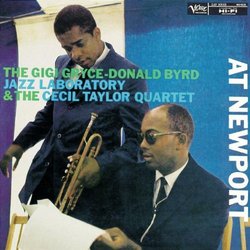| All Artists: The Gigi Gryce-Donald Byrd Jazz Laboratory, The Cec Title: At Newport Members Wishing: 2 Total Copies: 0 Label: Umvd Labels Release Date: 8/20/2002 Album Type: Live, Original recording remastered Genres: Jazz, Pop Style: Bebop Number of Discs: 1 SwapaCD Credits: 1 UPCs: 731458976424, 0731458976424 |
Search - The Gigi Gryce-Donald Byrd Jazz Laboratory, The Cec :: At Newport
 | The Gigi Gryce-Donald Byrd Jazz Laboratory, The Cec At Newport Genres: Jazz, Pop
|
Larger Image |
CD DetailsSimilar CDs
|
CD ReviewsTwo very different sets. Michael Stack | North Chelmsford, MA USA | 06/21/2005 (3 out of 5 stars) "A split LP finally receiving limited edition reissue on CD, "At Newport" is one of those things that more recent Cecil Taylor fans have been pining after for years-- Taylor's music took such a giant leap between his debut ("Jazz Advance") and its followup (the brilliant "Looking Ahead!") that any light that could be shed on what happened in the 21 months between those recordings is a worthwhile document. This recording is from roughly halfway between those two sessions, and is certainly interesting.
Before I go on, I should fairly state that while I enjoy some hard bop, I generally find the genre to be largely derivative of the mid-40s innovations of Parker, Gillespie, et.al. and am probably not the right person to critique the Gryce/Byrd portion of this show, but I'll take a stab at it anyway. Also to note before discussing the music-- the early Taylor material on Contemporary, United Artists and Candid (i.e. everything from before 1962) all suffer from poor fidelity courtesy of early '90s reissuing theory. This is the only example of early Taylor to have been remastered and the differences are remarkable-- clean, crisp sound, the original tapes must have been superb as it sounds like it was recording in 1997 not 1957. Good balance too, bass is distinct and clean and not at all muddy (although at least some of this is technique because Wendell Marshall on the second half lacks the clarity that Buell Neidlinger has), piano is resonant across its entire range, really, sonically this is just a pleasure to listen to. The performance itself-- it really is quite embryonic and shows the development of Taylor's style well. First thing that's clear is that Steve Lacy is fully integrated with Taylor's sound-- on his two cuts on "Jazz Advance", he sounded distinct and separated from Taylor-- here he sounds fully integrated with the leader. Taylor for his part makes little difference in his comping and his soloing style, providing counterpoint, countermelody, and harmony to the voice of Lacy (in fact quite similar to the way he'd play several years down the road). Admittedly, Taylor's playing is rather conservative compared to where he'd go, but his clustered chords are starting to emerge amidst more conventional soloing patterns-- my comment on "Jazz Advance" is equally valid here-- he sounds like he's improvising in a neoclassical context with swing rather than where he'd end up. A lot of this could be because of his rhythm section-- bassist Buell Neidlinger and drummer Dennis Charles have a harder time escaping the hard bop idiom than Lacy is having, and they're playing is still strongly grounded in that area (although check out Charles trading fours on "Nona's Blues"-- he's seriously caught fire!). Taylor even seems to yield to his rhythm section halfway, particularly on the originals. Taylor is in fact at his most extreme (for '57 anyway) on Billy Strayhorn's "Johnny Come Lately", where Lacy totally deconstructs the melody and Taylor is propulsive below him. The set by the Gigi Gryce-Donald Byrd Jazz Laboratory (featuring Gryce on alto, Byrd on trumpet, pianist Hank Jones, bassist Wendell Marshall, and drummer Osie Johnson) is firmly lodged in advanced hard bop, although when placed alongside even Taylor's relatively early work, it sounds positively conservative, most notably in Jones' performance-- the contrast between him and Taylor leaves his comping behind the generally firey Byrd and (to a lesser extent) Gryce to seem rather dull. Blues "Batland" in the middle is a pretty dull number that holds very little interest and seems to be uninspiring to Byrd, but opener "Splittin'" (introduced as "Ray's Way") fares slightly better, in particular because of some ferocious playing from Johnson (although oddly enough when the spotlight turns on him, he seems far less interesting). One website referred to the set as a chaser after Taylor's, and this is probably accurate, its really quite difficult to think of this as anything but music to cool off to. All in all, its a reasonable set, of most interest to Taylor fans for its crispness and (until recently) rarity." |

 Track Listings (6) - Disc #1
Track Listings (6) - Disc #1
![101 Piano Masterpieces [Box Set]](https://nationalbookswap.com/cd//m/70/0470/6170470.jpg)